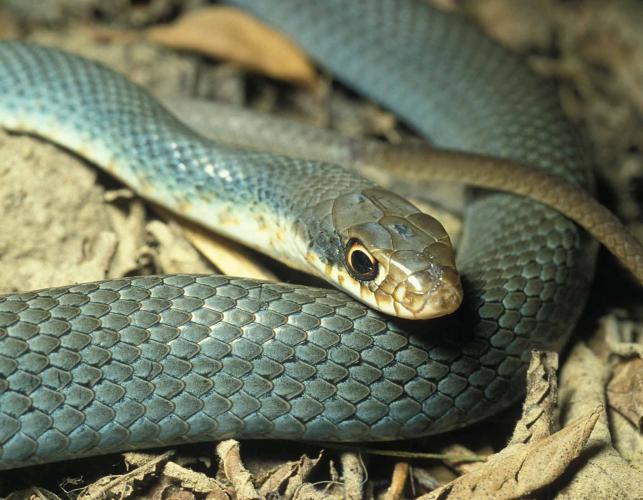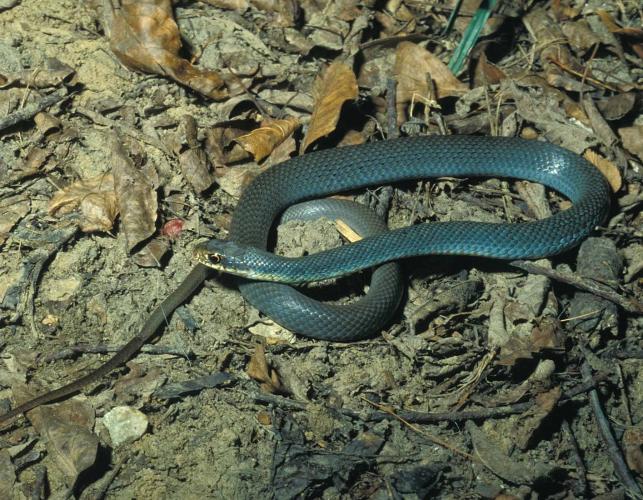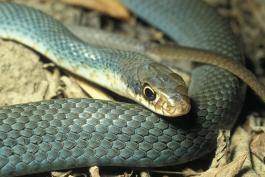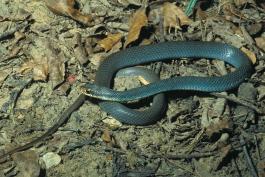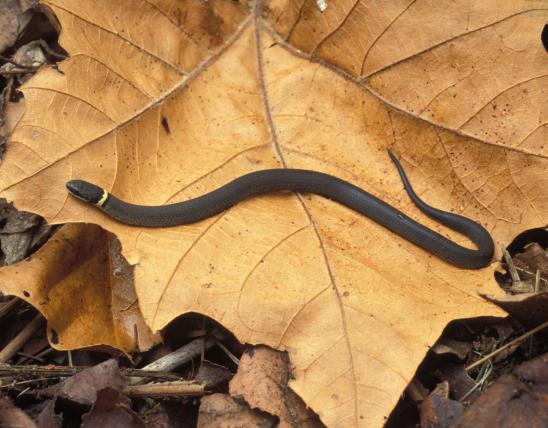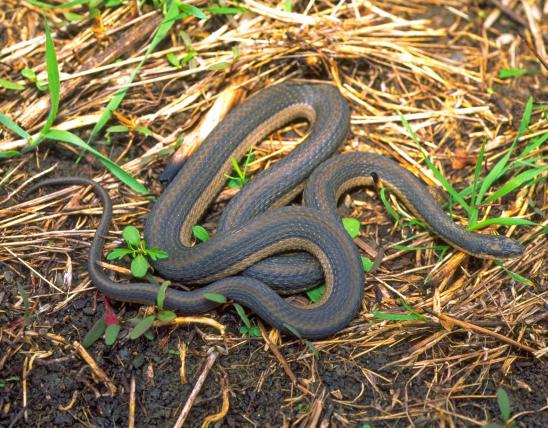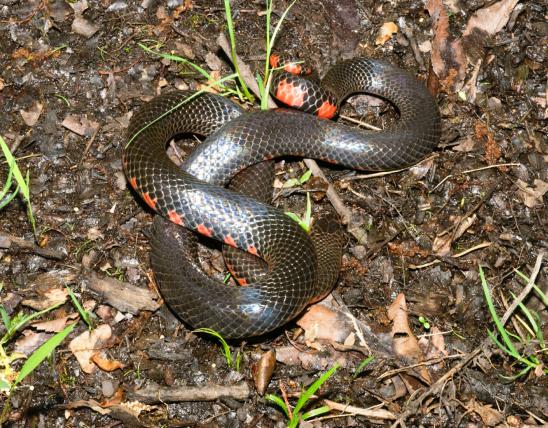
Missouri has at least two subspecies of the North American racer (Coluber constrictor). They occur in different parts of the state, and the ranges appear to overlap through much of the Ozarks. Racers have a slender body, proportionately long tail, and smooth body scales. As the name implies, racers can move fast, especially through tall grass or brush. These fast-moving snakes depend on speed and agility to escape predators and to overtake prey.
- The eastern yellow-bellied racer subspecies (Coluber constrictor flaviventris) is a medium to large, slender, smooth-scaled snake with a uniform but variable dorsal (upperside) color — adults three years of age or older can be tan, brown, olive, blue, gray, or nearly black. The belly is yellow, ivory, or light blue gray. This subspecies apparently occurs throughout most of Missouri, excluding the Bootheel.
- The southern black racer subspecies (Coluber constrictor priapus) is usually uniformly dark gray to bluish black and has a prominent white chin and throat. It apparently occurs in about the southeastern half of Missouri, and in much of its Missouri, range, it appears to overlap with the eastern yellow-bellied racer subspecies. However, it is the only subspecies occurring in the Bootheel lowlands.
Hatchlings and young racers are strongly patterned with closely spaced gray or brown mid-dorsal blotches and smaller, alternating spots on the sides over a tan ground color. The belly of young racers is cream colored with some dark gray speckling. The juvenile pattern fades with age, and by the third season most or all of the dorsal spots disappear.
When alarmed, racers try to escape quickly and sometimes vibrate their tails. When captured, they struggle violently, bite viciously, and discharge musk and waste matter from their vents.
Similar species: Racers captured in the St. Louis area have a blue body coloration that is similar to a third subspecies, the blue racer (C. c. foxii), which occurs east of the Mississippi River.
See Status for more discussion of the subspecies and distributions in Missouri.
Adult total length: 23 to 50 inches; occasionally to 75 inches.
The North American racer species occurs statewide. The different subspecies have different ranges within the state. The eastern yellow-bellied racer subspecies occurs nearly statewide, though not in the Bootheel. In southeastern Missouri, it overlaps with and is replaced by the southern black racer subspecies, which does occur in the Bootheel. The southern black racer's range may include as much as the southeastern half of the state. See Status for more information.
Habitat and Conservation
Racers are active March through November, with a peak from late April to early August. They are active during daytime. People often see them as they forage or bask on sunny days. Racers also climb into small trees or bushes. They are highly visual; in grasslands, they often raise their heads up above the vegetation to view the world around them.
Racers live in a wide variety of habitats, including native prairies, grasslands, pastures, old fields, glades, brushy areas, forest edges, and agricultural fields. In spring and fall, racers are often found on rocky, wooded, south-facing hillsides.
The southern black racer subspecies has been less studied in Missouri. They have been observed along swamps near limestone bluffs, soybean fields, and brushy areas near drainage ditches in southeastern Missouri. They appear to be most abundant within the remaining sand prairie and sand savanna habitat of southeastern Missouri.
Overwintering habitats are diverse. On wooded, south-facing hillsides, racers overwinter beneath rocks, in rock crevices, and in rotting logs and stumps. In more open habitats, racers may overwinter in animal burrows, such as those made by mammals and crayfish. They may also overwinter in caves, sometimes along with other species such as western ratsnakes. They will also spend winter in human structures such as stone walls, building foundations, abandoned wells, and cisterns.
Food
Eastern yellow-bellied racers eat a variety of animals, including many small mammals, especially rodents, as well as lizards, small snakes, frogs, birds, and insects.
Despite the Latin species name (constrictor), racers are not constrictors. They use their speed and agility to overtake prey. They quickly seize prey with their mouth and swallow it alive. Larger prey items often are pinned to the ground and chewed until death prior to swallowing.
Status
Missouri's populations of the North American racer (Coluber constrictor) require additional research in order to understand the distributions of our different subspecies.
First, the eastern yellow-bellied racer (C. c. flaviventris) and southern black racer (C. c. priapus) need to be sorted out. Throughout much of the Ozarks, there appears to be more of a southern black racer influence based upon coloration, but it is unclear if southern black racers are more widely distributed in Missouri, or if this coloration represents intergradation of the southern black racer and eastern yellow-bellied racer.
Additionally, racers captured in the St. Louis area have a blue body coloration similar to a third subspecies, the blue racer (C. c. foxii), which occurs east of the Mississippi River.
Are these colorations caused simply by genetic variation among individuals? Are the distributions of these three subspecies changing? Additional genetic research should help us better understand the distribution and taxonomy of these racers.
Life Cycle
Courtship and mating occur soon after these snakes emerge from overwintering retreats, usually in early April and throughout the spring. Egg-laying is in mid-June to late July. The female lays 8–21 eggs under logs or large rocks, or in rotten stumps, sand, compost piles, sawdust piles, or abandoned mammal burrows. The eggs hatch in about 2 months, in August and September, but incubation time varies with temperature and moisture and can vary from 40–97 days.
Individuals become sexually mature at about age two or three. Lifespan can be 10 years, and most likely, considerably longer.
Human Connections
Many Missourians know this species as the “blue racer.” The name racer is fitting due to their incredible speed as they are often seen fleeing quickly across a road or into their surroundings.
For as long as there have been humans, snakes have captured our imaginations. In myth, religion, and story, snakes perform the role of seducer, sneak, guardian, healer, killer, and transformer. They symbolize power, wisdom, sexuality, and life itself, and have been worshiped and reviled.
A colorful bit of old-time Ozark folklore reported by Vance Randolph involves the "blue racer." This myth had it that the snake would chase people, "particularly little boys playing truant from school." One is left to wonder if this story actually served to improve the boys' attendance, or if it caused them to poke around looking for exciting, fast snakes.
Ecosystem Connections
Racers are predators of many small animals, but as with many other predatory species, they can be preyed upon themselves by other predator animals, including larger mammals and by birds such as hawks. The eggs and young are especially vulnerable.

